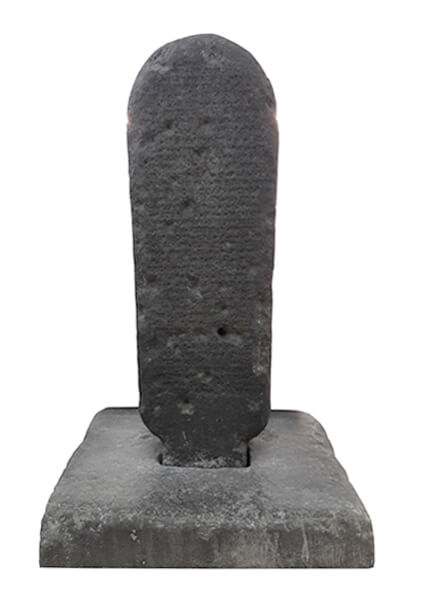According to the data obtained so far, the tradition of writing in the Eastern Anatolia Region started with the Urartu Kingdom. The Urartians adapted the cuneiform scripts took from New-Assyrian to their own language in time by using Assyrian. In Urartu, the writing is handled on artifacts made from various materials such as clay, metal, bone and mostly stone. An important part of the stone inscriptions are the handled texts on a panel that opens to a rock on a path. In addition to this, the independent stone steles constitute an important group. The building inscriptions in the royal buildings, the largest group in stone inscriptions also has architectural element function. Among the metal artifacts, the short inscriptions, which mostly are on the bronze artifacts and which state it belongs to which king, stand out. In addition, the presence of a few clay tablets and bullas is known. We also see cuneiform writing in some seals. They used cuneiform scripts on pottery to indicate more scale or the quality of the goods in it as well as they also used the caption. In Urartu, the written language is in the form of very standard and repetitive texts. It begins with the name of God and sometimes speaks of the king's quite exaggerated activities. According to other ancient Near Eastern civilizations, the tradition of writing which started in Urartu quite late has a limited usage area. The use of writing to indicate mostly kingdom activities has limited the issues covered. The stone inscriptions, which are the majority of the inscriptions, mostly focus on military expeditions, zoning activities, agricultural activities and religious rituals. The stone inscriptions also contain exceptional inscriptions on the sporting activities of the kings such as skipping or jumping. The limited availability of information about social life in Urartu is also due to the low number of clay tablets that came to hand. The contents of the tablets, which came to hand in a limited number, consist of land donation, bread and arms distribution, assignment and transfer of goods. In the short inscriptions on the clay bullas that have increased in excavations in recent years, very valuable information has been obtained about the exchange of goods between Urartu centers and the people and city names. In Urartians who paid great attention to the architectural design of the buildings, cuneiform inscriptions were seen as a decorative element besides its functional use. Thus, the fronts of the graves and rock monuments and especially the entrances of the structures are decorated with inscriptions in accordance with the architecture. Here, aesthetic concerns are in the forefront.
Urartian Language
The point reached in the studies on the mother tongue of Urartian language has not reached a very decisive conclusion. However, it is generally accepted that this language carries close relationships with Hurrian Language, which seems to be widely spoken in the 2nd millennium BC in Eastern and Southeastern Anatolia and Northern Syria. But it should be noted that they are not directly developed from Hurrian Language, probably they are two separate languages spoken in the same period. The most dominent feature of Urartian Language is its ergative structure. Ergativity is the case in which it contains the sentences and subjects made with transitive verbs. Although the degree of relationship between the living languages of Urartian Language is controversial, it has been determined that it has similar characteristics with Eastern Caucasian languages. At this stage, The closest similarity of Hurrian Language and Urartian Language with the Eastern Caucasian languages is due to its ergative feature. In all these languages, the subject is in nominative case in the sentences with intransitive verbs. In the sentences formed with transitive verbs, the object is innominative case and the subject is in an ergative case. As a result, some connections with Eastern Caucasian languages have been identified in recent studies. These languages are Dargi-Lezgi, Laki, Avar-And, Chechen-Ingush.
Urartian Cuneiform
As we mentioned before, the most common type of inscription used by the Urartians is the rock inscriptions. The total number of Urartian written documents detected until today is around 1700. 300 of them are stone inscriptions consisting of comprehensive texts. Most of them are rich in content, although they are filled with standard subjects and stereotyped expressions. There are approximately 30 clay tablets. The remaining inscriptions consist of two-line texts or person names. This kind of short inscriptions are present on clay bullas, royal oblation objects made of mostly bronze and again personal belongings of the kingdom family. In Urartu we can consider the development process of cuneiform in three stages. In the beginning, the writings of New-Assyrian were used with Assyrian language. In other words, the earliest inscriptions of Urartu were written in Assyrian using Assyrian cuneiform. In the second stage, the process of adaptation to the Urartian language begins and at this stage the writing is applied to the local language. However, the texts are written using both the local language and the source language quoted. In the third and last stage, it is seen that the adaptation process has made great progress and its own writing system has been created completely using Urartian Language. At this point, the text was written and used in accordance with the requirements of Urartian Language by developing. The Urartian cuneiform has undergone all stages of the development of writing, which we tried to outline above. The 6 inscriptions on the stone blocks in Madir Burç structure located at the west end of the Van Castle by the founder of the kingdom, I. Sarduri are in Assyrian Language: “The inscription (tablet) of Sarduri(who) is the son of Lutibri, the great king, the strong king, the king of allthings, the king of Nairi Country, unique king, surprised stepherd, not afraid of war, is subjugated to rebellious. (I) Sarduri, the son of Lutibri, king of kings, racketeered from all kings. Sarduri, the son of Lutibri says that: I brought the limestones of this building from the city of Alniunu. I built this wall.” There are not many bilingual inscriptions in Urartu. An interesting example of the Assyrian-Urartian bilingual inscription of King Minua, located in the village of Kevenli in Van, the center of Urartu. As a matter of fact, most of the Assyrian-Urartian bilingual inscriptions were found in the places that formed the border lines of Assyria and Urartu. These inscriptions are bilingual stelas such as Topzawa, Mergeh Karwan, Movana and Kelişin of the Urartian king I. Rusa. The building tablets in Urartu were mostly written on hard stones such as basalt, gabbro and diorite. For the rock inscriptions, The monuments or panels opened to the surface of the main rock made of the most soft limestone or andesite were completely smoothed and the signs were engraved. At this point, it is certain that the processing of cuneiform writing on hard volcanic stones requires quite serious artistic skill. At this stage, some scientists argue that Urartian stone masters may not have preferred the reliefs too much for some cultural reasons, although they were able to produce in the reliefart such in other contemporary cultures of the Near East. Because the aesthetic appearance of the cuneiform is also quite impressive considering the monuments in question. Cuneiform blocks decorating the front of Van-Ayanis Temple and the inscriptions which may be deemed artwork, decorating the front of I. Argişti Tomb in Van Castle may be cited for this situation. Although it is obvious that the Urartian script was taken from Assur, it is understood that its appearance has taken its own form. This situation has developed a unique writing style. For example, in Urartu, attention was paid not to interrupt the signs each other by considering the material to be applied cuneiform. At this point, more horizontal and vertical signs were used. In some examples, the lines are separated from each other by smooth horizontal lines. If we approach the text language used by the Urartians in the inscriptions again, it is understood that a very bossy and strict style has been used. The king's absolute authority is felt in the inscriptions, and here an Assyrian influence can also be spoken of. In Urartu examples, talking of a king, deputy god in the name of god is usually in question. In the next stage, the king's activities and commands are given in a certain discipline. For example, the expedition with god’s command, the expedition route and the captured cities are given in a certain order. Again, numerical figures are given for the army that is moved during the expedition. The captured spoils and captives are also sometimes ranked according to their qualifications. At the end of the inscriptions, there is usually a curse text against the people who will damage it: “İşpuini, the son of Sarduri and Minua, the son of İşpuini were planted this stela to master god Haldi. God Haldi made sail with its spear, defeated Uiteru tribe, defeated Luša tribe and defeated Katarza tribe. God Haldi is strong and powerful with the spear of God Haldi. With the power of God Haldi, İşpuini, the son of Sarduri and Minua, the son of İşpuini made sail against Luša tribe. Ispini was strong, and Minua was strong. There were 66 chariots, ….thousand 460 cavalry and 15,760 infantry in the army. God Haldi went before İşpuini, the son of Sarduri and Minua, the son of İşpuini. They rebuffed Luša and Katarza.... They gone ahead towards the city of Anaše and towards the great city of Kuquru. To Uiteruḫi, Luša ve Katarza tribes... Reinforcements from the kings of the country of Etiuhi Country came to help. God Haldi, with its spear made sail againsy Uiteruḫi, Luša and Katarza tribes and the kings of Etiuḫi Country. God Haldi was strong and the spear of God Haldi was also strong. İşpuini, the son of Sarduri and Minua, the son of İşpuini made sail, they rebuffed reinforcements of Uiteruḫi, Luša and Katarza tribes and Etiuḫi Country kings... From there they came to Anaše City. ... thousands 720 men, ... thousands 670 women, ...hundred 26 horses, 13.540 bovines, 20.785...” Another important type of the Urartian inscriptions is the building inscriptions. These can be found in the column bases of the royal buildings in the citadels, or they can be like channel inscriptions dated to Minua Period located in Edremit Kadembastı (Katepants) today. Minua, the powestrongful king of Urartu, built a large canal to bring the water to the Van Plain and placed stone blocks in his name on the support walls in some parts of the canal. Although these inscriptions are almost identical in terms of content, they are also important in terms of quality; “Minua, the son of İşpuini opened this channel thanks to the power of God Haldi. It's called Minua. Thanks to the greatness of God Haldi, Minua, the strong king, the great king, the king of the Biainili countries is the master of the Tuşpa city.. Minua says: Whoever deletes this text, who sees this, whoever told to another ‘I opened this channel’; is ruined by God Haldi, God Teishba, God Shivini and all the gods; shut off from sunlight.” Another inscription in the same region is one of the rare examples in Urartu. As already mentioned, there is little inscription in Urartu that gives information about social life or daily life. The inscription informs us about the various zoning activities carried out in relation to the Minua Channel; “This vineyard belongs to Minua's wife, Tariria. His name is Taririahini.” In the inscription, we learn that Minua, the King of Urartu had a vineyard done for his wife. The area where the inscription is located today is in a semicircle form and is opened towards Van Lake and is famous for its vineyards. The inscription is one of the few inscriptions in the Urartian society that gives information on the position of noble women.
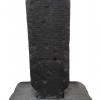
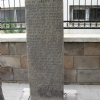
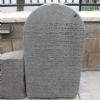
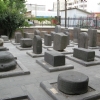
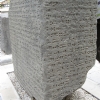
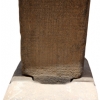
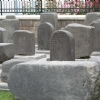
TOPZAWA STELİ
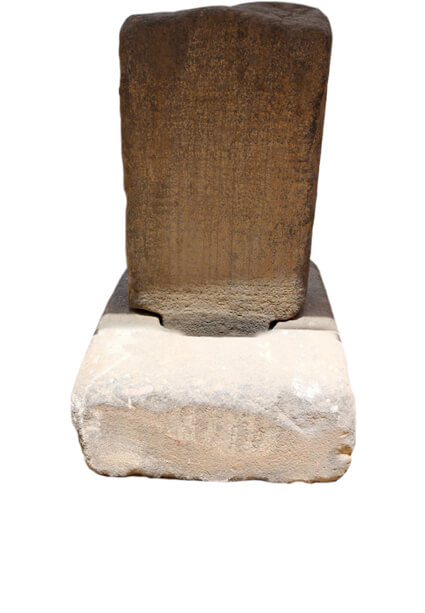
KALEŞİN STELİ
